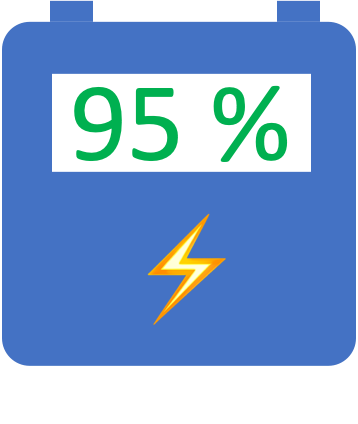Can boats be powered by solar panels?
A solar boat is a boat that is 100% autonomous thanks to the photovoltaic energy from its solar panels. Specially designed to sail infinitely on solar energy, even at night, it is fitted with batteries. A good captain can manage the power and pilot the boat for years without recharging from the grid.
Manage the electric range
Principles
The theoretical range of an electric boat depends on 2 key factors essentials to understand.
- Battery capacity is expressed in watt-hours (Wh). The higher the battery capacity, the greater the range.
- The power used by the motor determines electrical consumption. It is expressed in watts (W) or kW (1 kW = 1000 W). A 6 kW motor may only be used at 1 kW most of the time, which has nothing to do with the 6 kW maximum power, which may be useful for safety reasons.
Range in hours is given by the ratio Capacity (Wh) / Power (W). For example, if your battery stores 6 kWh and you drive your motor at 1000 W, then your range is 6 hours (=6 x 1000 / 1000).
Speed is often associated with pleasure. This is not always obvious. In solar navigation, it's important to distinguish between speed for pleasure and speed for autonomy.
Pleasure speed
This is the optimum speed for passenger pleasure and safety. This speed depends on weather conditions. For example, sailing at maximum boat speed reduces comfort in swell conditions. It's even dangerous if you're going fast on flat seas and suddenly come across the wake of a motor yacht. A reserve of power offers some security in bad weather, but the bigger the waves, the lower the comfort speed. This speed also depends on the position of the passengers on the boat. With passengers seated at the bow, it is advisable to be extremely vigilant to prevent them from falling into the water. Ultimately, the optimum speed depends on the waves, the sailing program and the crew.
Experience of private tours in the bay of Saint-Jean-Cap-Ferrat in good weather shows that enthusiasm reaches its peak when the boat is sailing at a speed near 3 knots with passengers sitting in the front or 4-5 knots with passengers in the center.
Solar autonomy speed
The performance of a solar boat depends on its hydrodynamics and energy efficiency. All other things being equal, it is measured in good sunshine and sea conditions.
The solar autonomy speed corresponds to the speed in knots at which the solar boat can move forward indefinitely with only its solar roof as a source of energy. It is measured when the photovoltaic power produced corresponds to the power consumed by the motor and the boat is sailing at 90% battery charge. By extension, the battery is considered charged when it is above 90%.
Solar autonomy speed can be higher than pleasure boating speed, demonstrating that autonomy of solar boat is not an issue.
Solar extended range
It is possible to exceed the solar autonomy speed, or even to push the motor to its maximum power, provided of course that the sea conditions and battery preservation are taken into account. In this case, you'll need to manage your energy more carefully, depending on your sailing schedule. Each stop at anchor or in port will be an opportunity to extend the autonomy.
The range extension corresponds to the increase in nautical miles, of the boat's autonomy, during a stop. Thus, for a solar roof producing 1000 W, the battery can store up to 2 kWh for 2 hours in full sunlight. If the speed of the boat pushed to 1000 W is 4 knots, and all things being equal otherwise, then the increase in autonomy after 2 hours at anchoring is 8 nautical miles.
Navigate as often as possible
Are you aware that more than 50% of those who take the licence do not use it within a year of their training or abandon their projects? Taking the boat licence is not the be-all and end-all of being a true sailor. Plan to sail often to stay at the top! Apart from energy management, there's little difference from a normal boat, except that the speed of a sailboat encourages you to listen to the sea, to follow the trajectory of the waves, to feel the wind. What's more, the pleasure of passengers sitting forward with their feet in the water encourages the captain to pay particular attention to passenger safety.
Basic tips
 |
In navigation, do not stand in the front or back. Stay seated on the seats. Children are under the responsibility of the parents. |
 |
For dock manoeuvres, approach at 1 knot. The crew accompanies the manoeuvre by releasing gently with their hands or feet. |
 |
Observe the speed limit in the harbour (approx. 5 km/h). |
 |
For your safety do not approach the coast except in the anchorage areas. At less than 100 m, a GPS alert will trigger a systematic inspection of the floats on your return. Always stay within the navigation zone marked on the map. |
 |
Locate the divers' flags and then go around at least 100 m. |
 |
Locate the fishing net buoys and then go around for at least 100 m. |
 |
Deviate your course or stop the propellers in case of floating objects. The electric motor is silent. In case of abnormal noise, stop everything and check that the propellers are clear. Swimmers do not hear the propellers starting, at anchor, remove the circuit breaker. |
|
|
Navigate in solar autonomy. Charging the batteries constitutes a reserve of power that you must keep at more than 95% charge by day and 90% by night . |
| In case of unexpected strong waves and for your comfort, stay seated on the back benches, reduce speed before the wave. In case of diving, let the wave run on deck and watch your personal belongings. | |
 |
The draught is 50 cm at propeller level. Moor on sandy bottoms, on an area free of algae or posidonia and without rocks. Moisten the entire chain, which must rest horizontally on the bottom. |
To know more...
How complicated is it to drive a solar boat?
It all depends on your initial level. The Club includes guides and quizzes to help you understand the specifics of solar driving.
What does solar navigation have to offer?
It's a new lifestyle, and many news are shared here.


